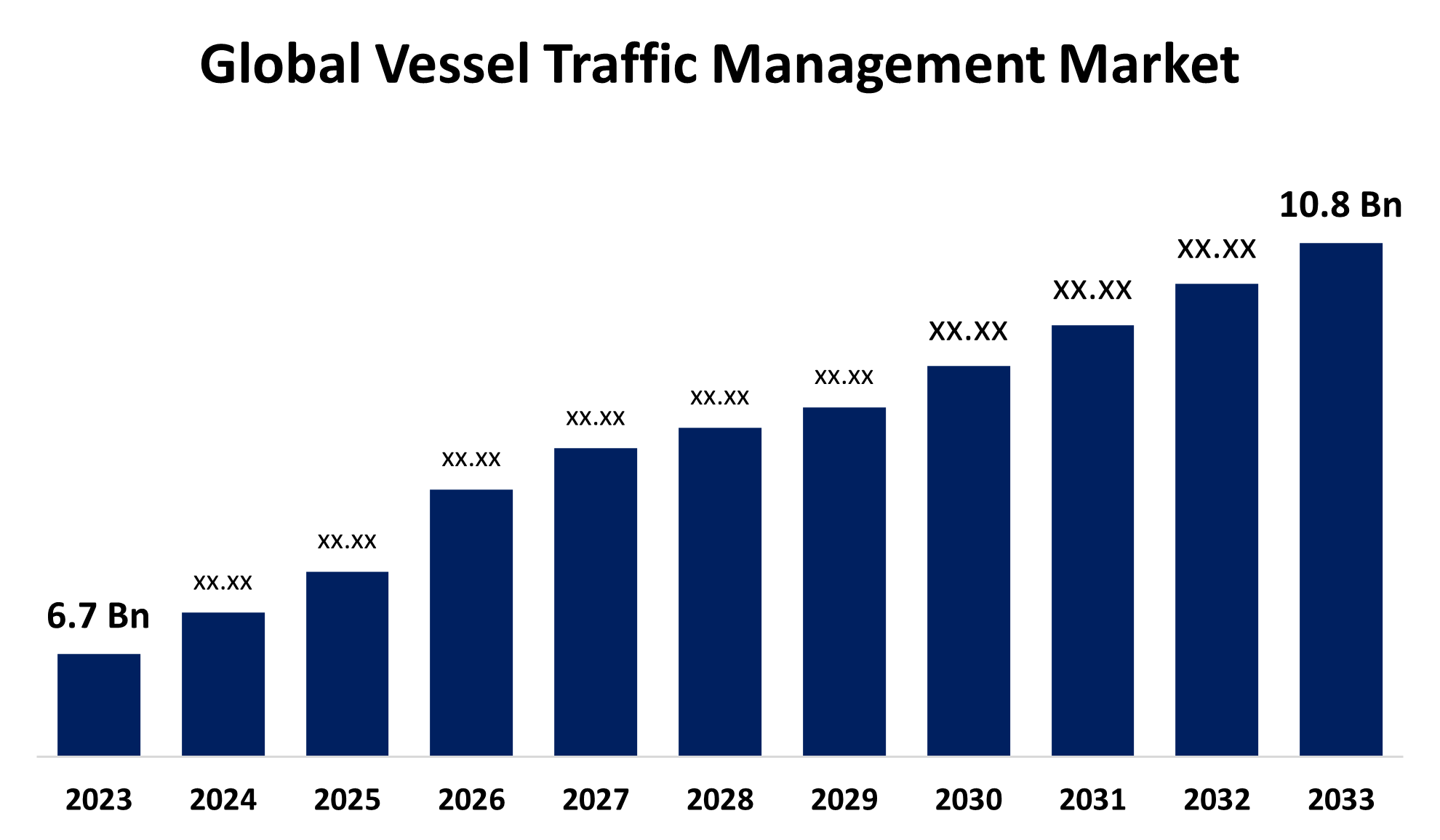Global Vessel Traffic Management Market Size, Share, and COVID-19 Impact Analysis, By Component (Equipment, Solution, and Service); By Investment (Brownfield, Greenfield); By End-Use (Commercial Sector, Defence Sector), and By Region (North America, Europe, Asia-Pacific, Latin America, Middle East, and Africa), Analysis and Forecast 2023 - 2033
Industry: Aerospace & DefenseGlobal Vessel Traffic Management Market Insights Forecasts to 2033
- The Vessel Traffic Management Market Size was valued at USD 6.7 billion in 2023.
- The market Size is Growing at a CAGR of 4.89% from 2023 to 2033.
- The Worldwide Vessel Traffic Management Market Size is expected to reach USD 10.8 billion by 2033.
- Asia Pacific is expected to grow the fastest during the forecast period.

Get more details on this report -
The global Vessel Traffic Management Market is expected to reach USD 10.8 billion by 2033, at a CAGR of 4.89% during the forecast period 2023 to 2033.
The Vessel Traffic Management market is experiencing significant growth due to the rising need for maritime safety, efficient port operations, and enhanced coastal surveillance. Vessel Traffic Management systems integrate radar, Automatic Identification System (AIS), communication technologies, and software solutions to monitor and regulate vessel movements. The market is driven by increasing global trade, strict maritime regulations, and growing concerns about environmental protection. Major end-users include ports, offshore platforms, and naval agencies. Technological advancements such as artificial intelligence, the Internet of Things, and cloud computing are further improving system capabilities. However, high implementation costs and cybersecurity threats remain key challenges. The Asia-Pacific region is emerging as a dominant market due to rapid port developments in China, India, and Southeast Asia. Leading players include Kongsberg Gruppen, Saab AB, and Leonardo S.p.A.
Vessel Traffic Management Market Value Chain Analysis
The Vessel Traffic Management market value chain consists of multiple interconnected stages, ensuring efficient maritime operations. It begins with raw material suppliers providing components such as radar systems, sensors, and communication devices. Technology developers and system integrators then design and assemble Vessel Traffic Management solutions, incorporating software, AI, and IoT-based analytics. These solutions are deployed by ports, coastal authorities, and offshore operators for vessel monitoring and traffic control. Service providers play a crucial role in maintenance, upgrades, and cybersecurity protection. Regulatory bodies establish compliance standards to enhance maritime safety. End-users, including commercial ports, navy fleets, and offshore platforms, leverage these systems for operational efficiency and environmental protection. Key stakeholders include equipment manufacturers, technology firms, government agencies, and maritime service providers, collectively driving market growth.
Vessel Traffic Management Market Opportunity Analysis
The Vessel Traffic Management market presents significant growth opportunities driven by increasing global trade, rising maritime security concerns, and advancements in digital technologies. The expansion of smart ports and the integration of artificial intelligence, big data analytics, and IoT in vessel monitoring create new avenues for market players. Governments and port authorities are investing heavily in modernizing maritime infrastructure to enhance operational efficiency and safety. Emerging economies, particularly in Asia-Pacific, offer lucrative opportunities due to rapid port developments in China, India, and Southeast Asia. Additionally, the push for greener shipping solutions and stricter environmental regulations encourage the adoption of advanced traffic management systems. Despite challenges like high implementation costs and cybersecurity threats, the growing demand for real-time vessel tracking and automation fuels market expansion.
Global Vessel Traffic Management Market Report Coverage
| Report Coverage | Details |
|---|---|
| Base Year: | 2023 |
| Market Size in 2023: | USD 6.7 Billion |
| Forecast Period: | 2023-2033 |
| Forecast Period CAGR 2023-2033 : | 4.89% |
| 2033 Value Projection: | USD 10.8 Billion |
| Historical Data for: | 2019-2022 |
| No. of Pages: | 210 |
| Tables, Charts & Figures: | 110 |
| Segments covered: | By Component, By Investment, By End-Use, By Region |
| Companies covered:: | Some of the key market players of the market are the Wartsila Corporation, Kongsberg Gruppen AS, General Electric Co., Northrop Grumman Corporation, Marlink AS, L3 Technologies, Japan Radio Co. Ltd., Leonardo Finmeccanica, Kelvin Hughes, Marlan Maritime Technologies, Elcome International LLC., Xanatos Marine Ltd., TERMA, Saab AB, Thales Group, Rolta India, and Tokyo Keiki Inc. |
| Pitfalls & Challenges: | Covid-19 Empact, Challenges, Growth, Analysis |
Get more details on this report -
Market Dynamics
Vessel Traffic Management Market Dynamics
Rising vessel congestion at ports to dive the market growth
Rising vessel congestion at ports is a key factor driving the growth of the Vessel Traffic Management market. Increasing global trade, larger cargo volumes, and expanding maritime traffic are causing delays and inefficiencies at ports worldwide. To address these challenges, port authorities and shipping companies are investing in advanced Vessel Traffic Management systems that enhance real-time monitoring, optimize ship movements, and improve overall operational efficiency. Technologies such as AI, IoT, and automated traffic control systems are being integrated to streamline port operations and reduce turnaround times. Additionally, stricter maritime regulations and environmental concerns are further encouraging the adoption of these solutions. As major ports, especially in Asia-Pacific and Europe, face increasing congestion, the demand for effective vessel traffic management systems continues to rise, driving market expansion.
Restraints & Challenges
High implementation and maintenance costs pose a significant barrier, especially for smaller ports with limited budgets. Cybersecurity threats are another major concern, as increased digitalization and cloud-based systems expose maritime operations to potential cyberattacks. Additionally, integrating new Vessel Traffic Management systems with existing port infrastructure can be complex and time-consuming. The lack of skilled personnel to operate and manage advanced technologies further hampers market growth. Regulatory compliance and evolving international maritime safety standards also require continuous system upgrades, increasing operational expenses. Moreover, geopolitical tensions, supply chain disruptions, and fluctuating global trade patterns create uncertainties in market expansion. Addressing these challenges requires industry-wide collaboration and investment in secure, scalable, and cost-effective solutions.
Regional Forecasts

Get more details on this report -
North America Market Statistics
North America is anticipated to dominate the Vessel Traffic Management Market from 2023 to 2033. The U.S. and Canada are key contributors, investing in advanced traffic management solutions to enhance port efficiency and maritime safety. Government agencies, such as the U.S. Coast Guard and Transport Canada, enforce stringent regulations that mandate the adoption of modern vessel monitoring systems. The integration of AI, IoT, and cloud-based analytics is further transforming port operations, reducing congestion and improving real-time decision-making. Additionally, rising concerns over cybersecurity and environmental sustainability are pushing ports to upgrade their traffic management infrastructure. Major ports along the Gulf of Mexico, the Atlantic, and the Pacific coasts are leading adopters, creating lucrative opportunities for market players in the region.
Asia Pacific Market Statistics
Asia Pacific is witnessing the fastest market growth between 2023 to 2033. The region's strong economic growth, driven by manufacturing and exports, has led to congestion at major ports, necessitating modern monitoring and control systems. Government initiatives to develop smart ports, coupled with the integration of AI, IoT, and automation, are further driving market adoption. Additionally, stricter environmental regulations and maritime security concerns are pushing ports to upgrade their vessel traffic management infrastructure. Asia-Pacific remains a dominant market, attracting global players looking to capitalize on the region’s expanding shipping and logistics sector.
Segmentation Analysis
Insights by Component
The equipment segment accounted for the largest market share over the forecast period 2023 to 2033. Increasing vessel traffic and port congestion are driving demand for radar systems, Automatic Identification Systems (AIS), sensors, and surveillance cameras to enhance maritime safety and operational efficiency. Technological advancements, such as AI-powered predictive analytics and IoT-enabled smart sensors, are further improving real-time vessel tracking and traffic control. Ports, coastal authorities, and offshore platforms are investing in modern equipment to comply with stringent maritime regulations and environmental standards. Additionally, growing concerns over cybersecurity are fueling demand for secure communication systems. With expanding maritime trade and smart port initiatives, the equipment segment is expected to play a crucial role in the overall growth of the Vessel Traffic Management market.
Insights by Investment
The brownfield segment accounted for the largest market share over the forecast period 2023 to 2033. Many ports worldwide are facing congestion, inefficiencies, and outdated traffic management systems, driving investments in upgrading radar, sensors, and communication networks. Governments and port authorities are integrating advanced technologies such as AI, IoT, and cloud-based analytics into legacy systems to improve vessel tracking, reduce delays, and enhance operational efficiency. Stricter maritime regulations and environmental concerns are also encouraging brownfield port upgrades to meet compliance standards. The high cost and complexity of developing new ports make brownfield modernization a more viable solution. With growing global trade and rising vessel traffic, the brownfield segment is expected to play a key role in shaping the future of the Vessel Traffic Management market.
Insights by End Use
The commercial sector segment accounted for the largest market share over the forecast period 2023 to 2033. Major seaports, container terminals, and logistics hubs are investing in advanced traffic management solutions to optimize vessel movements, reduce congestion, and enhance operational efficiency. Technologies such as AI, IoT, and real-time data analytics are being integrated into commercial port systems to improve navigation, automate processes, and ensure regulatory compliance. Stricter environmental and security regulations are further driving demand for modern vessel monitoring solutions. Additionally, the rapid development of smart ports, especially in high-traffic regions like Asia-Pacific and North America, is fueling market expansion. As maritime trade volumes continue to rise, the commercial sector remains a key driver of growth in the Vessel Traffic Management market.
Recent Market Developments
- In June 2021, Wärtsilä Voyage has successfully upgraded the “Croatian National Vessel Traffic Management & Information System” and implemented the newly developed “Sea Traffic Management.” This project marks the first installation of STM in the Adriatic Sea, significantly improving the safety and efficiency of maritime operations in Croatian waters.
Competitive Landscape
Major players in the market
- Wartsila Corporation
- Kongsberg Gruppen AS
- General Electric Co.
- Northrop Grumman Corporation
- Marlink AS
- L3 Technologies
- Japan Radio Co. Ltd.
- Leonardo Finmeccanica
- Kelvin Hughes
- Marlan Maritime Technologies
- Elcome International LLC.
- Xanatos Marine Ltd.
- TERMA
- Saab AB
- Thales Group
- Rolta India
- Tokyo Keiki Inc.
Market Segmentation
This study forecasts revenue at global, regional, and country levels from 2023 to 2033.
Vessel Traffic Management Market, Component Analysis
- Equipment
- Solution
- Service
Vessel Traffic Management Market, Investment Analysis
- Brownfield
- Greenfield
Vessel Traffic Management Market, End Use Analysis
- Commercial Sector
- Defence Sector
Vessel Traffic Management Market, Regional Analysis
- North America
- US
- Canada
- Mexico
- Europe
- Germany
- UK
- France
- Italy
- Spain
- Russia
- Rest of Europe
- Asia Pacific
- China
- Japan
- India
- South Korea
- Australia
- Rest of Asia Pacific
- South America
- Brazil
- Argentina
- Rest of South America
- Middle East & Africa
- UAE
- Saudi Arabia
- Qatar
- South Africa
- Rest of the Middle East & Africa
Frequently Asked Questions (FAQ)
-
What is the market size of the Vessel Traffic Management Market?The global Vessel Traffic Management Market is expected to grow from USD 6.7 billion in 2023 to USD 10.8 billion by 2033, at a CAGR of 4.89% during the forecast period 2023-2033.
-
Who are the key market players of the Vessel Traffic Management Market?Some of the key market players of the market are the Wartsila Corporation, Kongsberg Gruppen AS, General Electric Co., Northrop Grumman Corporation, Marlink AS, L3 Technologies, Japan Radio Co. Ltd., Leonardo Finmeccanica, Kelvin Hughes, Marlan Maritime Technologies, Elcome International LLC., Xanatos Marine Ltd., TERMA, Saab AB, Thales Group, Rolta India, and Tokyo Keiki Inc.
-
Which segment holds the largest market share?The brownfield segment holds the largest market share and is going to continue its dominance.
Need help to buy this report?